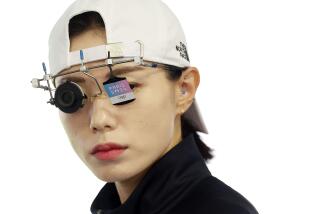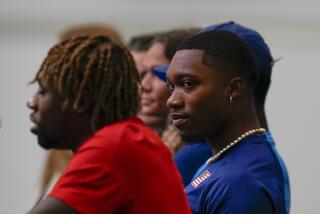SHOOTING / WORLD CUP : U.S. Shotgun Team Shoots Blanks, Draws Blank
- Share via
The United States won four medals Saturday at the 1990 World Cup USA Olympic-style tournament in Chino, but noticeably absent was a gold, silver or bronze in the skeet competition.
Al Mullins, 39, a mainstay on the U.S. shotgun team, came close. After missing only four clay pigeons out of 200 in the two-day event, Mullins had difficulty in the 25-shot final and finished fourth.
Mullins, from Fort Benning, Ga., lost the bronze in a sudden death shootout with Ennio Falco of Italy.
Mullins, who said he expects to retire after 13 years of competitive shooting next year, could hardly be blamed. His was a steady performance until the high-pressured shootoffs.
The U.S. shotgun team was shaky even before this tournament began.
In June at the U.S. Nationals, also held at Petersen’s Prado Tiro Ranges in Chino, two of the team’s best were suspended for two years after drug tests revealed they had cocaine in their systems.
Thus, Matt Dryke of Seattle, perhaps America’s finest shotgun shooter for the past 10 years, and Shawn Brack of Costa Mesa, were not present at the World Cup.
Neither will be eligible until 1991, but both still can qualify for the 1992 Olympics in Barcelona.
Dryke, who won a gold medal at the Los Angeles Games and a bronze at Seoul, said he is unsure whether he will return.
“I’ve lost interest,” Dryke said in a telephone interview from Squim, Wash. “I’ve won everything there is to win.”
His sister, Ellen, a World Cup competitor, said she thinks he will return. “He still picks up his 3200 shotgun every so often,” she said.
Dryke, 31, said the suspension surprised him, but he admitted using cocaine.
“I didn’t take it while I was shooting or even practicing,” he said. “I didn’t think it would have been in my system after 72 hours. That confused me. I don’t know what happened.”
Brack, 22, a graduate of Rancho Alamitos High in Garden Grove, knew what happened to him in June.
He said he took cocaine the night before his final in trap competition. Brack already has earned a qualifying score to compete in the Olympics if he makes the U.S. team in 1992.
He said he hopes to compete, but that is secondary to a more pressing issue.
“Sobriety is more important than shooting,” he said Saturday in a telephone interview. “I had a problem. I’m taking care of it.
“I’ll be back, but I’ve got to take care of myself first.”
To that end, Brack said he is getting daily treatment at a Costa Mesa clinic when he is not working as a tile layer.
He also said he did not take cocaine while shooting.
“But I’ll be a much better shooter when I return drug free,” Brack said.
Brack said he started taking drugs only six months before his suspension. He said shooting had overtaken his life and he realizes he wants to have more balance.
“Being so involved might have led to the problem,” said Brack, who has been shooting since 1981.
“It caused such bizarre behavior,” he said. “I was always angry and depressed. The only reason I could still shoot was because of my natural ability.”
Brack realizes how much the team needs him. He won a gold and silver in World Cup competition before his departure.
“The shotgun team isn’t too good without Matt and I,” he said.
Dryke is making trap machines and working at his father’s shooting club in Squim. He and his sister said his drug use is not habitual.
Mullins, formerly a teammate of Dryke’s on the U.S. Marksmanship Unit at Fort Benning, also said Dryke did not appear to have a drug problem.
“The boy had been tested all over the world and never had anything come up,” said Lloyd Woodhouse, U.S. national shooting coach. “Darn right I was shocked when I found out. It was just a stupid thing to do.”
Cocaine is not usually found among shooters. Performance enhancing drugs usually are alcohol or beta-blockers, substances that steady the nervous system.
While Woodhouse tries to mend a broken team, the Italians have an altogether different problem in shotgun shooting. They have to select the top three competitors when they have at least five worthy performers.
The coaches picked the wrong shooters for the World Cup.
Giusseppe Tassi of Civita Vecchia, near Rome, was not entered in the open competition and his spectacular round of 199 out of 200 went for naught. He was Italy’s fourth entry and shooting only to earn a qualifying round of 184.
When asked if he was disappointed, he shrugged and said, “Of course, but I knew the rules before I started shooting.”
Tassi, 36, had a perfect round until the final 25 shots when he finally missed on the difficult fifth stage as afternoon winds sent the birds flying wickedly.
Shooting Notes
Silvia Sperber, 25, of West Germany set a world record, winning the women’s standard three-position rife event with 679.5 points. Deena Wigger of Murray, Ky., was second and Launi Melli of Cheeny, Wash., finished third. . . . Toni Kuechler of Switzerland overcame John McNally of Fort Benning, Ga., to win the men’s rapid fire pistol. Eduardo Suarez of Pleasanton, Calif., was third. McNally had a big lead going into the final, but shot poorly to lose the gold and an Olympic slot given to every World Cup champion. . . . At the 1986 World Championships in East Germany, McNally came to the final without enough ammunition. An East German competitor gave him some extra bullets.
More to Read
Go beyond the scoreboard
Get the latest on L.A.'s teams in the daily Sports Report newsletter.
You may occasionally receive promotional content from the Los Angeles Times.







